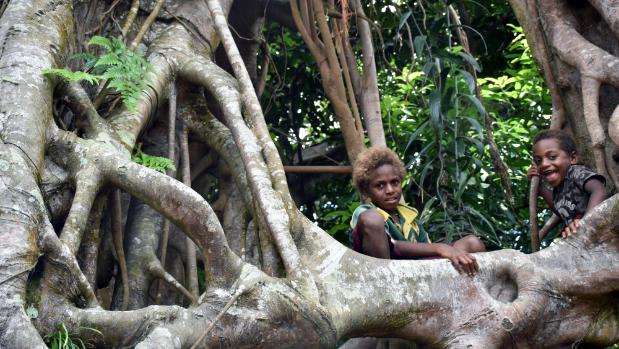
They are demonised as brutal killers but, as two studies published this month show, strangler figs can be lifesavers — of both plants and people.
According to research in the Australian Journal of Management, they contributed to the low death toll of Cyclone Pam, which hit the Pacific island nation of Vanuatu in 2015. When the cyclone destroyed homes there, people survived by taking shelter among the aerial roots of giant strangler figs.
This is more than just an anecdote. People in Vanuatu have been using giant fig trees to escape from cyclones for thousands of years, say Lachlan Forsyth and Rebecca Olul of UNICEF.
“For as long as people have lived on these islands, the trees have been a traditional cyclone shelter,” they write in an article published this week. “During cyclones, entire villages would wriggle down into the tree’s extensive root system, tucking children into the cavities, and waiting out the storm. Even if the tree were uprooted, the entire root structure would come up, leaving those within safely cocooned and protected from flying debris.”
These refuges exist because strangler figs start out in life as seeds that germinate high on other trees. They then send down roots that merge and split and merge again, thickening into a mesh that envelopes the host tree and — in time — erases all trace of it.
While most strangler figs grow on a single host tree, some — known collectively as banyans — are much bigger specimens. Their branches produce aerial roots that thicken into stout pillars that resemble tree trunks and enable the banyan to continue to expand as it ages.
The mass of roots that descends from a banyan’s body and branches creates a matrix of hollows and thick woody walls. In Vanuatu, these chambers have saved people from cyclones for generations.
Strangulation might sound like a brutal fate for the host tree, but before a strangler fig overcomes its host it can also protect it, say biologists Leora Richard and Sylvia Halkin in the new issue of Symbiosis. When they studied the aftermath of Cyclone Oswald, which hit Lamington National Park in Australia in 2013, they found that large trees were less likely to be uprooted if they hosted strangler figs.
By building a scaffold around their host and by anchoring their aerial roots in both the ground and around other trees, the strangler figs appear to protect the trees on which they grow.
So the stranglers can not only protect people directly, as living shelters, but can also help ensure fewer trees fall when a cyclone strikes. Elsewhere fig trees protect people from drought and from extreme rainfall. They sustain more wildlife than any other trees and can accelerate rainforest regeneration.
Collectively, they have much to offer as we come to terms with our fast changing climate.
References:
Handmer, J. & Iveson, H. 2017. Cyclone Pam in Vanuatu: learning from the low death toll. Australian Journal of Management 32 https://ajem.infoservices.com.au/items/AJEM-32-02-22
Richard, L.S. & Halkin, S.L. 2017. Strangler figs may support their host trees during severe storms. Symbiosis 72: 153–157. https://link.springer.com/article/10.1007/s13199-017-0484-5
Forsyth, L. & Olul, R. 2017. Unicef NZ: Climate change and preparing for the coming storm. stuff.co.nz (28 June 2017). https://www.stuff.co.nz/world/south-pacific/94193406/unicef-nz-climate-change-and-preparing-for-the-coming-storm
Photo credits:
Children play among the roots of a giant strangler fig in Vanuatu (UNICEF New Zealand)
Hi Mike,
this article reminds me of a restaurant in São Paulo that was built around a beautiful fig tree.
http://rubaiyat.com.br/en/figueira-rubaiyat/
Cheers,
Thanks Marcia. The restaurant in SP reminded me of another built under a big fig tree in Kenya: http://trout-tree.com
There is also a restaurant up a fig tree in Japan, but the tree is not real:
http://inhabitat.com/banyan-treehouse-restaurant-in-japan/
we have a banyan tree in front of our house . There is constant trouble with neighbours as they want it to be removed as they argue that it is a danger to their houses in future if it expands . It is 30 year old .
I DONT KNOW HOW TO SAVE IT. I am not worried about the safety of OUR house . In fact I believe it would protect the surroundings by binding the soil together and avoid any damage through any earth quake or deluge of water in case of severe rains. Any suggestion from any one in this issue .